Search:
Data Analysis
 |
The "3D NASA Logo" image is used as an image segmentation test image. This image is 200 x 200 pixels with a 3-element vector at each pixel representing the red, green, and blue spectral values. As a control to test the quality across the differenct segmentation approach, the target global dissimilarity criterion is 10. In the event that the different segmentation approaches can not reach the global criterion value of 10, they will get as close as possible while striving for a like quality across the approaches. |
|
 |
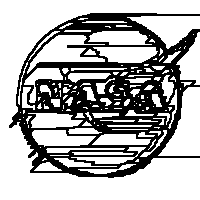 |
Figure 1
|
 |
 |
Figure 2
|
 |
 |
Figure 3
|
 |
 |
Figure 4
|
 |
 |
Figure 5
|
 |
 |
Figure 6
|
 |
 |
Figure 7
|
 |
 |
Figure 8
|
 |
 |
Figure 9
|
| Segmentation Approach Vs. Number of Regions Produced | |
|---|---|
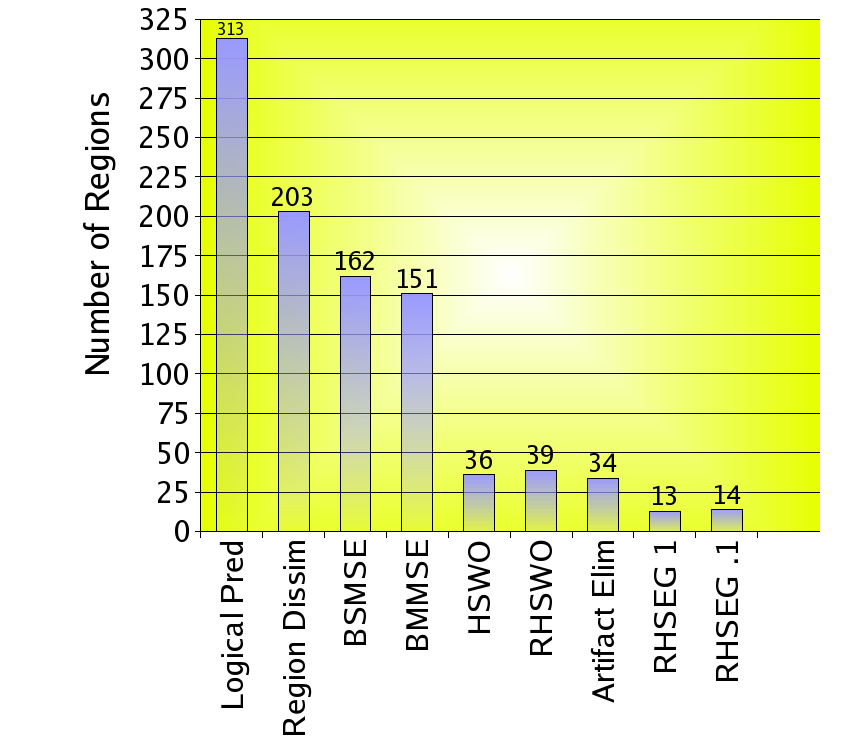 |
After obtaining close approximations of a global dissimilarity criterion value of 10 for each of the different approaches to image segmentation, this chart displays the difference in the number of regions produced from these approaches. |
| Region Growing Threshold vs Number of Regions Produced | |
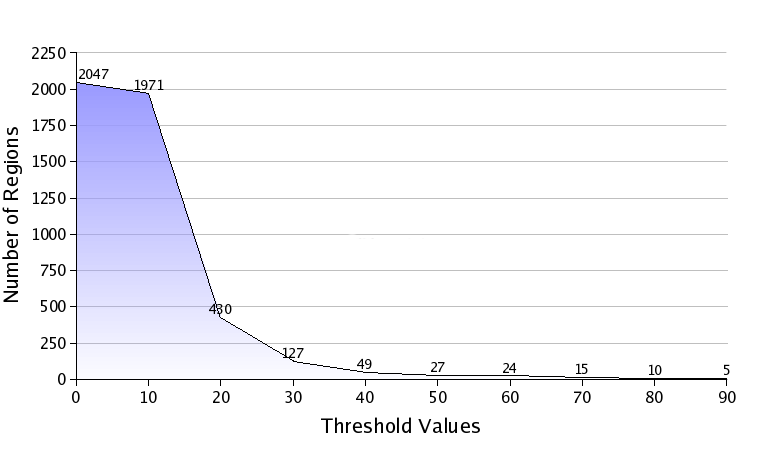 |
Chart 2 displays the relationship between the region growing threshold value and the number of regions produced, whereas the Logical Predicate Segmentation on "3D NASA Logo" is being used for the example. Although the Logical Predicate Segmentation results are displayed in the chart, the relationship between the threshold value and the number of regions holds true for all segmentation approaches: Logical Predicate Segmentation through BMMSE Region Dissimilarity Based, whose thresholds are iterated independently by the user, and HSWO through RHSEG, whose thresholds are iterated by the algorithm. From the information presented, it can be inferred that the region growing threshold value and the number of regions produced have an inverse relationship. |
| Region Growing Threshold vs. Global Dissimilarity Criterion Value Produced | |
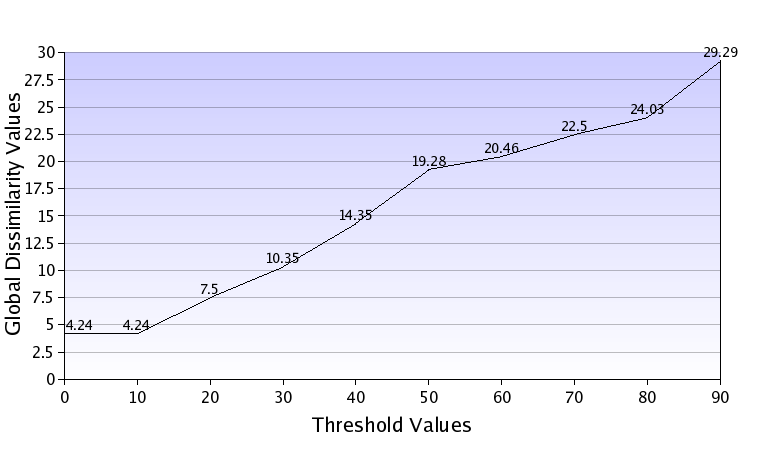 |
Chart 3 displays the relationship between the region growing threshold value and global dissimilarity criterion value produced, whereas the Logical Predicate Segmentation on "3D NASA Logo" is being used for the example. Although the Logical Predicate Segmentation results are displayed in the chart, the relationshiop between the threshold value and the global dissimilarity criterion values holds true for all segmentation approaches: Logical Predicate Segmentation through BMMSED Region Dissimilarity Based, whose thresholds are iterated independently by the user, and HSWO through RHSEG, whose thresholds are iterated by the algorithm. From the information presented, it can be inferred that the region growing threshold value and the global dissimilarity criterion value have a direct relationship. |
| Spectral Clustering produced Number of Regions vs. Global Dissimilarity Criterion Value Produced | |
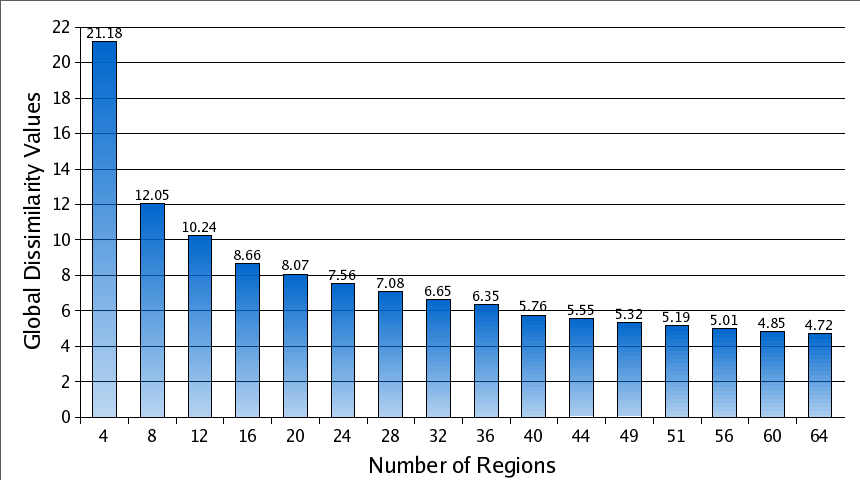 |
Chart 4 displays the relationship between the spectral clustering weight value and global dissimilarity criterion value produced on the premise that the independent variable is the number of regions. For this example, the spclust_wght is 1.0 as an addendum to the BSMSE Based Region Dissimilarity Function and the Processing Window Artifact Elimination algorithm activated. In this particular diagram, their is a inverse relationship between the number of regions and the global dissimilarity criterion value; meaning, that as the number of regions increase, the global dissimilarity criterion value decreases. Although, a spectral clustering weight of 1.0 is being used, the same relationship holds true for all spectral clustering weight between 1.0 and 0.1, however the values will vary based on the image. |
| Spectral Clustering Weight Value vs. Global Dissimilarity Value | |
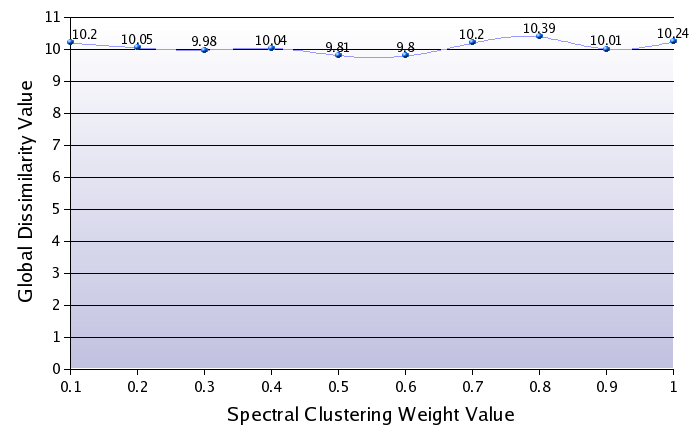 |
Chart 5 displays the relationship between the spectral clustering weight value and the global dissimilarity criterion value produced. The results displayed are produced by using the spectral clustering weight as the independent variable and a region number of 12 for the control. This chart utilizes results from processing the "3D NASA Logo" with the BSMSE based Region Dissimilarity Function and Processing Window Artifact Elimination algorithm. An analysis of the results show that a definite relationship does not exist. Although not pictured, other images' results using the same comparison and algorithm displayed a wavy, unstable movement, but not identical to the pattern of hills and valleys like Chart 5. Thus, it can be inferred that the specral clustering weight produces varied global dissimilarity criterion values as it is strictly dependent upon the image spectral attributes. |



